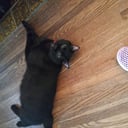In ancient Egypt, the shaving of eyebrows signified which type of death?
In ancient Egypt, cats were treasured pets. When the cats died, they were mummified. As a sign of mourning, the cat owners shaved off their eyebrows, and continued to mourn until their eyebrows grew back. To honor their cats, who were so special, art from ancient Egypt shows statues and paintings of every type of feline.
The Ancient Egyptians held cats in the highest esteem. The penalties for injuring or killing a cat were severe. Those who killed them, even by accident, were routinely sentenced to death.
Although historians cannot agree on exactly why or how, they can agree that cats were strongly tied to religion in ancient Egypt. Cats were seen either as demigods or as representatives of gods. They were given great protection because of this belief. Egyptians worshiped a Cat Goddess, often represented as half feline, half woman, whom they called Bastet. The more famous goddess Bastet replaced the first feline god Mafdet, who was worshiped for protection from poisonous bites from things like snakes and scorpions.
By the end of the 10th century BC, all types of domestic cats were extremely popular. When they died, they were embalmed, coffined, and buried in cat cemeteries. The domestic cat was regarded as the living incarnation of Bastet; the cat would protect the household against granivores and any other kind of intruder. The lion-headed (large cat) deity Sekhmet was worshiped as the overall protector of Egypt.
More Info:
kids.nationalgeographic.com













